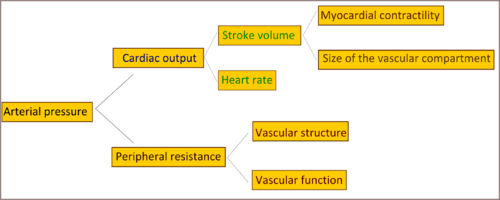
The pathophysiology of hypertension is an area of active research, attempting to explain causes of hypertension, which is a chronic disease characterized by elevation of blood pressure. Hypertension can be classified as either essential or secondary. Essential hypertension indicates that no specific medical cause can be found to explain a patient's condition. About 90-95% of hypertension is essential hypertension. Secondary hypertension indicates that the high blood pressure is a result of another underlying condition, such as kidney disease or tumours (adrenal adenoma or pheochromocytoma). Persistent hypertension is one of the risk factors for strokes, heart attacks, heart failure and arterial aneurysm, and is a leading cause of chronic renal failure.
Most mechanisms leading to secondary hypertension are well understood. The pathophysiology of essential hypertension remains an area of active research, with many theories and different links to many risk factors.
Cardiac output and peripheral resistance are the two determinants of arterial pressure. Cardiac output is determined by stroke volume and heart rate; stroke volume is related to myocardial contractility and to the size of the vascular compartment. Peripheral resistance is determined by functional and anatomic changes in small arteries and arterioles.
Source : wikipedia

Tidak ada komentar:
Posting Komentar